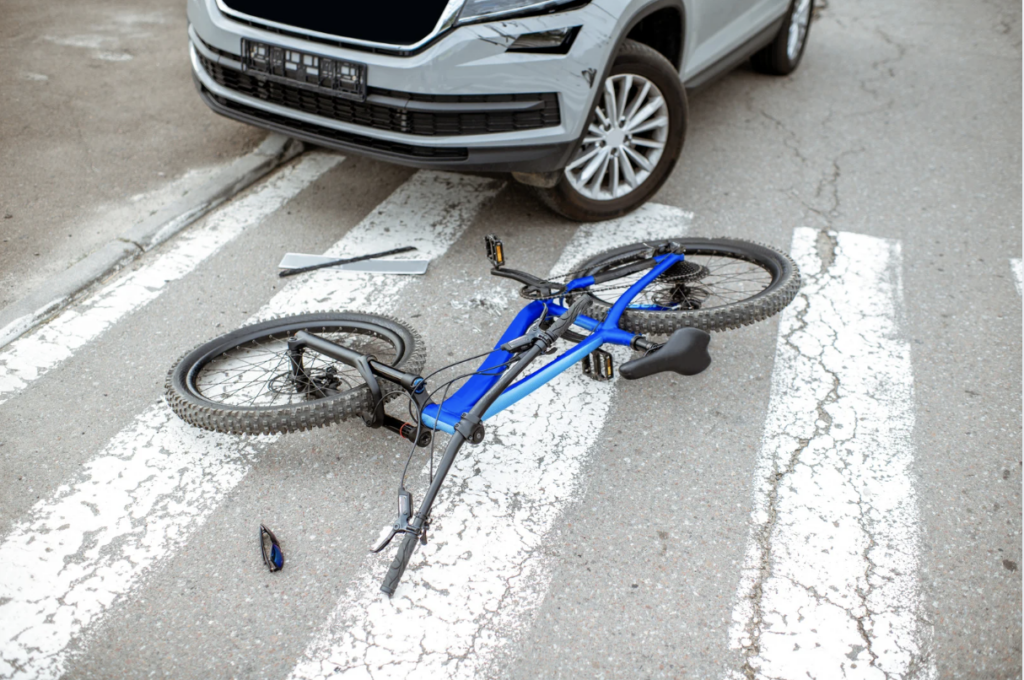
Florida consistently ranks as one of the most dangerous states for bicyclists, with hundreds of serious injuries and numerous fatalities reported each year. Without the protection, bicyclists are at a significantly higher risk of severe injury or death in collisions with motor vehicles. It is crucial to understand the types of injuries that result from bicycle accidents and to be aware of your legal options for seeking compensation.
At Holliday Karatinos Law Firm, we are dedicated to helping injured cyclists recover the compensation they deserve. In this guide, we’ll cover the most common injuries sustained in bicycle accidents, how liability is determined, and the steps you can take to pursue a personal injury claim.
The Dangers Cyclists Face on the Road
Despite growing awareness and infrastructure improvements, bicyclists are still at high risk for traffic collisions. According to the National Highway Traffic Safety Administration (NHTSA), over 900 cyclists are killed and tens of thousands are injured in U.S. traffic crashes each year. Florida consistently ranks among the states with the highest number of bicycle fatalities.
Common causes of bicycle accidents include:
- Distracted or inattentive drivers
- Dooring (when a parked car door opens into a cyclist’s path)
- Unsafe lane changes or turns by vehicles
- Failure to yield at intersections
- Poorly maintained roads or bike lanes
Common Injuries in Bicycle Accidents
Because of the limited protection available to cyclists, the injuries resulting from bike crashes are often severe and life-altering. Some of the most common injuries include:
1. Traumatic Brain Injuries (TBIs)
Even with a helmet, a cyclist can suffer a concussion or more severe brain trauma in a crash. TBIs may result in long-term cognitive impairments, mood disorders, and memory loss.
2. Spinal Cord Injuries
Damage to the spinal cord can result in partial or total paralysis. These injuries often require extensive medical treatment, rehabilitation, and lifelong care.
3. Broken Bones and Fractures
Collisions often result in broken arms, legs, ribs, or collarbones. Recovery may involve surgery, casting, and physical therapy.
4. Road Rash
When cyclists are thrown from their bike, they may slide along the pavement, causing painful abrasions that can lead to infection or permanent scarring.
5. Facial and Dental Injuries
Falls or collisions can cause broken jaws, lost teeth, and facial lacerations. These injuries may require reconstructive surgery or ongoing dental treatment.
6. Internal Injuries
Organ damage or internal bleeding may occur, especially if the cyclist is struck by a motor vehicle. These injuries can be life-threatening and may not be immediately apparent.
7. Psychological Trauma
In addition to physical injuries, many cyclists experience post-traumatic stress disorder (PTSD), anxiety, and depression following an accident.
Long-Term Consequences of Bicycle Accident Injuries
Many injuries sustained in a bicycle accident can have lasting consequences. Victims may face:
- Chronic pain
- Reduced mobility or function
- Lost income due to time off work or inability to return to a previous job
- Ongoing medical expenses
- Need for assistive devices or home modifications
These long-term effects highlight the importance of securing compensation that reflects the true scope of a victim’s losses not just immediate medical costs.
Who Can Be Held Liable for a Bicycle Accident?
Establishing fault is essential for pursuing a personal injury claim. Depending on the circumstances, one or more parties may be liable, including:
- Drivers of motor vehicles who acted negligently
- Municipalities responsible for maintaining safe road conditions
- Bicycle or parts manufacturers if a mechanical defect contributed to the accident
- In commercial vehicle companies if the driver was operating a company vehicle
In Florida, the legal principle of comparative negligence applies. This means a cyclist can still recover compensation even if they were partially at fault, as long as they are found to be less than 51% responsible.
Florida Bicycle Laws & Rights of Cyclists
Understanding your rights as a cyclist under Florida law can strengthen your claim and help you stay safe. Key points include:
- Bicyclists have the same rights and responsibilities as motor vehicle drivers.
- Florida law requires motorists to leave at least three feet of clearance when passing a bicycle.
- Cyclists under the age of 16 are required to wear a helmet.
- Bicycles are permitted on roadways and sidewalks, but local ordinances may vary.
- Cyclists must use bike lanes where available but may leave the lane to avoid hazards.
Being aware of these laws helps protect your rights and provides a legal foundation if you're injured due to a motorist’s negligence.
Legal Rights for Cyclists in Bike Lanes and Crosswalks
Bike lanes and crosswalks are meant to offer cyclists a safer way to travel, but they’re not immune from negligent drivers. Many collisions occur when drivers:
- Fail to yield to cyclists in crosswalks
- Turn across bike lanes without checking for cyclists
- Enter or block bike lanes illegally
In Florida, cyclists have the right-of-way in crosswalks and when traveling lawfully in a designated bike lane. If you’re injured in one of these protected areas, the driver may be presumed negligent—especially if traffic signals or signage were violated. Photos, witness testimony, and video footage are key forms of evidence in these cases.
How Evidence Strengthens Your Claim
Proper documentation is one of the most powerful tools in a bicycle injury claim. Beyond medical records and photos, the following forms of evidence can make a significant difference:
- Helmet or GoPro footage: Can visually confirm how the crash occurred
- GPS or fitness tracker data: Can demonstrate your speed and direction
- Eyewitness accounts: Especially helpful when liability is contested
- Damage inspection reports: May reveal the angle or force of impact
- Street camera footage or 911 call logs: Provide time-stamped validation of events
Saving and organizing this evidence can give your attorney more leverage when negotiating with insurers or presenting your case in court.
Dealing With Insurance Adjusters After a Bicycle Accident
Insurance companies often try to settle quickly and for less than you deserve. Keep these best practices in mind when dealing with adjusters:
- Do not give a recorded statement without legal advice
- Avoid downplaying your injuries, even casually
- Request all communication in writing to maintain a record
- Do not accept the first settlement offer without legal review
- Consult your attorney before signing anything
Remember, insurance adjusters are not on your side. Their job is to minimize payouts not ensure fair compensation. Having an experience bicycle accident attorney handle these communications protects your interests.
Steps to Take After a Bicycle Accident
Your actions after an accident can significantly affect the outcome of your claim. Here’s what to do:
- Call 911 and seek medical attention – Even if injuries appear minor, some may not show symptoms right away.
- Report the accident – A police report provides a crucial record.
- Gather evidence – Take photos of the scene, your bike, the vehicle, and your injuries. Collect contact information from any witnesses.
- Avoid admitting fault – Statements made at the scene can be used against you later.
- Preserve damaged property – Keep your damaged bicycle, helmet, and clothing as potential evidence.
- Consult a personal injury attorney – Legal representation is vital to navigating the claims process and maximizing compensation.
Types of Compensation Available
If you’ve been injured in a bicycle accident caused by someone else’s negligence, you may be entitled to recover compensation for:
- Medical expenses (past, current, and future)
- Lost wages and loss of earning capacity
- Pain and suffering
- Emotional distress
- Disfigurement or disability
- Property damage (repair or replacement of your bicycle and gear)
Legal Considerations in Wrongful Death Bicycle Accident Claims
When a bicycle accident results in a fatality, surviving family members may be entitled to pursue a wrongful death claim. Under Florida law, a wrongful death claim can be filed by the personal representative of the deceased’s estate on behalf of surviving relatives such as a spouse, children, or parents.
Potential compensation may include:
- Funeral and burial expenses
- Medical bills incurred prior to death
- Loss of companionship, guidance, and support
- Loss of the decedent’s future earnings
Wrongful death cases often require swift legal action to preserve evidence and meet Florida’s two-year statute of limitations. These claims are complex and emotionally challenging, which makes experienced legal representation essential.
Litigation vs. Settlement: What Cyclists Should Know
Most bicycle accident claims are resolved through settlement negotiations. However, if an insurance company refuses to offer fair compensation or disputes liability, your attorney may recommend filing a lawsuit. Knowing the difference between settling and litigating can help you make informed decisions.
Settlement Advantages:
- Faster resolution
- Less stressful than trial
- Often results in guaranteed compensation
When Litigation May Be Necessary:
- Disputes over fault or causation
- Serious or permanent injuries
- Claims involving commercial vehicles or government entities
How Florida’s No-Fault Insurance Rules Affect Cyclists
Florida is a no-fault state for auto insurance, meaning that drivers must carry Personal Injury Protection (PIP) coverage. However, cyclists are not required to carry PIP. If a motorist hits you while biking, you may still access PIP benefits through your own auto policy (if you have one) or a household member’s policy.
Important notes:
- PIP typically covers 80% of medical expenses and 60% of lost wages
- PIP benefits are capped and do not cover pain and suffering
If your injuries are severe or involve significant medical costs, you can pursue a claim against the at-fault driver for full damages beyond what PIP covers.
Talk to an Experienced Bicycle Accident Lawyer Today
If you or a loved one has been injured in a bicycle accident caused by a negligent driver, defective road conditions, or any other factor, you may be entitled to compensation for your injuries, lost income, and pain and suffering. Navigating a claim can be overwhelming, especially when dealing with insurance companies that often undervalue bicycle-related injuries.
At Holliday Karatinos Law Firm, our experienced bicycle accident lawyers are committed to fighting for the rights of injured cyclists across Florida. We understand the physical, emotional, and financial toll these accidents take, and we’re here to help you recover every dollar you deserve.
Don’t delay. Reach out today for a free, no-obligation consultation, and let us put our legal experience to work for you.
Frequently Asked Questions (FAQs)
What types of evidence are most useful in a bicycle accident case?
Photographs of the accident scene, damage to your bike, visible injuries, and road conditions are essential. Additional helpful evidence includes police reports, medical records, surveillance or dashcam footage, GPS or fitness tracker data (such as from Strava or Garmin), and witness statements. The more documentation you have, the stronger your claim will be.
Can I file a claim if I wasn’t wearing a helmet?
Yes. While not wearing a helmet may factor into a comparative negligence evaluation, it does not disqualify you from seeking compensation. Florida law currently requires helmets only for riders under 16, and liability is determined based on the actions of all parties involved—not just protective gear use.
What if the driver fled the scene after hitting me?
You may still be eligible for compensation through your own uninsured/underinsured motorist (UM/UIM) coverage, if applicable. An attorney can also assist in investigating the incident to help identify the hit-and-run driver using traffic camera footage, witness statements, or police reports.
How long do I have to file a personal injury claim in Florida?
The statute of limitations in Florida is generally two years from the date of the bicycle accident. However, if a government entity is involved, shorter deadlines and specific procedures may apply. Prompt legal consultation ensures you don’t miss critical filing windows.
Will my case go to trial?
Most bicycle accident claims are resolved through settlements without going to court. However, if the insurance company denies liability or offers an insufficient settlement, your attorney may recommend filing a lawsuit and preparing for trial to pursue full compensation.
Can I recover damages for emotional and psychological trauma?
Yes. Psychological injuries such as PTSD, anxiety, depression, and emotional distress are recognized damages in personal injury cases. Documentation from mental health professionals can strengthen your claim and help secure compensation for these non-economic losses.Yes. Emotional distress, PTSD, and other psychological injuries can be included in a personal injury claim.









